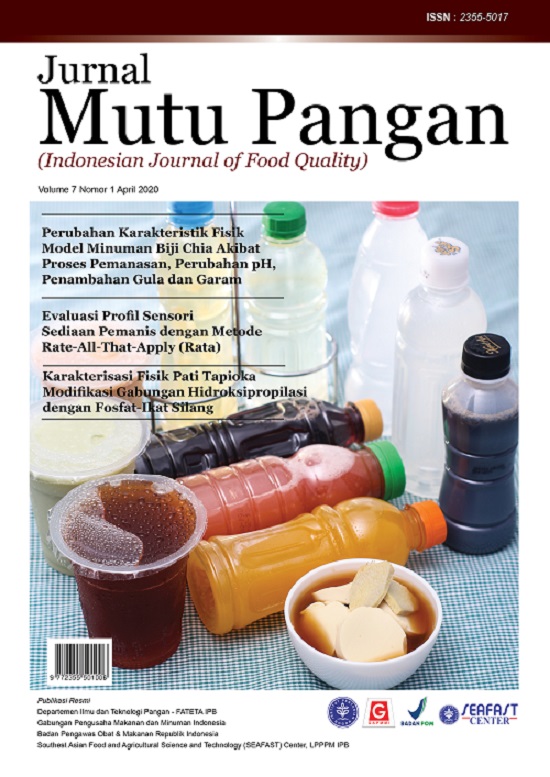Pengujian Kapasitas Antioksidan Wedang Tahu dalam Rangka Meningkatkan Mutu Fungsionalnya
Abstract
Efforts to prevent and overcome various degenerative diseases can be realized by developing functional foods that are known as natural or processed foods containing bioactive components that have the potential to improve health status. One of whole foods that has potency to be developed as functional food is soft tofu dessert. Soft tofu dessert has two main components which are soft tofu and ginger drink. However, there is lack of references providing the evidence of the characteristics and health benefit or soft tofu dessert. This study provide data to support the development of soft tofu dessert as a whole food that has optimum characteristic and contains benefit for health as well. The research objectives were to test radical scavenging capacity of soft tofu dessert and its component by implementing DPPH method. Antioxidant capacity of the samples was observed by using DPPH method (517 nm). Ranges of concentration were observed to determine IC50 of each sample. IC50 value presents the inhibition of 50% DPPH radical by samples. The values of IC50 for ginger water extract, ginger drink, soft tofu, and soft tofu dessert were 1592.40±22.30 ppm, 2764.26±90.29 ppm, 24657.50±2483.11 ppm, and 3356.04±415.54 ppm respectively. This result showed the best radical scavenging capacity was ginger water extract > ginger drink > soft tofu dessert, and > soft tofu. Soft tofu dessert performed better scavenging capacity than soft tofu itself, but still performed the lower capacity compared to ginger water extract and ginger drink.
Downloads
References
Awe FB, Fagbemi TN, Ifesan BOT, Badejo AA. 2013. Antioxidant properties of cold and hot water extracts of cocoa, Hibiscus flower extract, and ginger beverage blends. Food Res Int 52: 490–495. DOI : 10.1016/j.foodres.2013.01.021.
Boly R, Lamkami T, Lompo M, Dubois J, Guissou IP. 2016. DPPH free radical scavenging activity of two extracts from Agelanthus dodoneifolius (loranthaceae) leaves. Int J Toxicol Pharmacol Res 8(1): 29-34.
Chen Z, Bertin R, Froldi G. 2013. EC50 estimation of antioxidant activity in DPPH assay using several statistical programs. Food Chem 138: 414–420. DOI: 10.1016/j.foodchem.2012.11.001.
[EC] European Commission. 2010. Functional Foods. European Union (EU), Luxemburg. DOI: 10.2777/85512.
Giada MLR. 2014. An approach about in vitro antioxidant capacity of plant foods and beverages. Demetra: Food Nut Health 9(1): 137-146. DOI: 10.12957/demetra.2014.8256.
Gupta RK, Chawla P, Tripathi M, Shukla AK, Pandey A. 2014. Synergistic antioxidant activity of tea with ginger, black pepper, and tulsi. Int J of Pharm Pharmaceut Sci 6 (5): 477-479.
Han RM, Zhang JP, Skibsted LH. 2012. Reaction dynamics of flavonoids and carotenoids as antioxidants. Review. Molecules 17: 2140-2160. DOI: 10.3390/molecules17022140.
Kim JK, Kim Y, Na KM, Surh YJ, Kim TY. 2007. [6]-Gingerol prevents UVB-induced ROS production and COX-2 expression in vitro and in vivo. Free Radic Res 41: 603–614. DOI: 10.1080/10715760701209896.
Murad M, Abdullah A, Mustapha WAW. 2013. Antioxidant capacity and amino acid profiles of egg tofu. Am J Appl Sci 10 (11): 1315-1324. DOI: 10.3844/ajassp.2013.1315.1324.
Rodríguez-Roque MJ, Rojas-Graü MA, Elez-Martínez P, Martín-Belloso O. 2013. Soymilk phenolic compounds, isoflavones and antioxidant activity as affected by in vitro gastrointestinal digestion. Food Chem 136: 206–212. DOI: 10.1016/j.foodchem.2012.07.115.
Shalaby EA, Shanab SMM. 2013. Comparison of DPPH and ABTS assays for determining antioxidant potential of water and methanol extracts of Spirulina platensis. Indian J Geo-Marine Sci 42(5): 556-564.
Shirin APR, Jamuna P. 2010. Chemical composition and antioxidant properties of ginger root (Zingiber officinale). J Med Plants Res 4 (24): 2674-2679. DOI: 10.5897/JMPR09.464.
Shurtleff W, Aoyagi A. 2013. History of Tofu and Tofu Products (965 ce to 2013). Soyinfo Center, Lafayatte.
Stoilova I, Krastanov A, Stoyanova A, Denev P, Gargova S. 2007. Antioxidant activity of a ginger extract (Zingiber officinale). Food Chem 102: 764–770. DOI: 10.1016/j.foodchem.2006.06.023.
Vayuphard B, Laksanalamai V. 2012. Recovery of antioxidants from grape seeds and its application in fried food. J Food Process Technol 3(4): 1-6. DOI: 10.4172/2157-7110.1000152.
Wangcharoen W. 2012. Development of ginger-flavoured soya milk ice cream: comparison of data analysis methods. Maejo Int J Sci Tech 6(03): 505-513.
Widyanto R, Palupi NS, Refli R, Kahfi J, Prangdimurti E. 2017. Optimization of soft tofu and ginger drink formula as components of soft tofu dessert using response surface metodhology (RSM). Int Food Res J 25(5): 1818-1828.
Yakubu N, Oboh G, Olalekan AA. 2013. Antioxidant and hepatoprotective properties of tofu (curdle soymilk) against acetaminophen-induced liver damage in rats. Biotech Res Int 1-7. DOI: 10.1155/2013/230142.
Yeh H, Chuang C, Chen H, Wan C, Chen T, Lin L. 2014. Bioactive components analysis of two various gingers (Zingiber officinale Roscoe) and antioxidant effect of ginger extracts. LWT - Food Sci Technol 55: 329-334. DOI: 10.1016/j.lwt.2013.08.003.

















